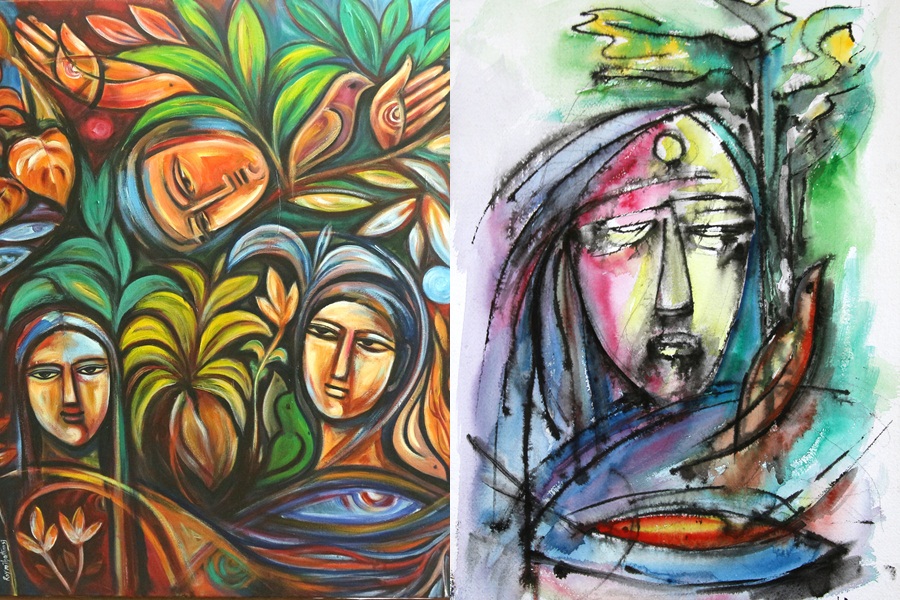
Today the world faces environmental challenges from climate change to plastic pollution to the loss of bio-diversity. We have encountered flood, drought and disorder in seasons. I try to reflect here on how art and Mother Earth are intrinsically linked together and the role of artists in creating new vision to magnify ‘how earth like the heavens narrates the glory of God’.
Artists and artistic expression are heavily dependent on Mother Earth. Nature is the reference point for the artists from Pre-historical period to Post Modern era. Artists are always intrigued with the Earth, with its mysterious aspects, powers and beauties. Art opens up and exhibits a dimension of the reality that is not accessible either to common observation or to scientific investigation. Art works express the quest for “a secret, primal meaning slumbering beneath the world of appearances” (Carl G. Jung 1964).
Prehistoric people’s art was the means to connect their personal and community realm with the wider Cosmic realm. They discovered their humanness, and they uncovered the mysterious powers of the Earth through art. Also, art was a means for them to express and share their inner experiences while encountering the powers of the Nature. While travelling through the Earth they were travelling through their ‘inner-scape’ through their artistic expressions. “Art is eternal, for it reveals the inner landscape; which is the soul of man”, Martha Graham, a dancer and choreographer testifies.
Almost all the works of the artists of the world, from the primitive to the modern, symbols and motifs from nature are essentially an integral part of the artistic expression. The whole Cosmos is potentially a symbol according to Carl Jung. The symbols and god figures taken from nature of the Primitive people have deeply influenced some to the modern movements in art as the new Primitivism. This quest for returning to the ‘primitive’ view of life and reality is a major concern in many forms of modern art. The other concern is to integrate it more vitally with the Environment by trying to inspire a child’s wonder in the world of reality and our environment. An encounter with any form of art is therefore another opportunity to know a little more about ourselves and our identity in this Planet.
For an artist there are no boundaries. Everything is connected. S-He walks through the heart of the Earth. S-He hears the music of the seasons; S-he laughs with the rivers and sings with the birds. S-He stands still with the mountains in meditation, and dances with the trees. The Earth is her/his spiritual path towards God. Tagore said, “Nature is the face of God’.
The paintings of many of the Indian artists like A. Ramachandran and Laxman Pai are affirmation of the real world, and proclamation that the beauty and comfort of humans depend much on her/his Environment. By alienating ourselves from the Earth we lose our base, our connectedness with its primordial energy, and we lose our sense of the sacred. Artists are concerned about it, and they try to elevate the minds of people to the sacredness of the Earth and everything in it. The river of compassion flows in her/him. S-He becomes the wind of peace and burns with the fire of love. The tree of life grows within her /him... Artists always reach towards such unfathomable beauty of life and the Earth. We all are artists in its wider sense, because art is a spiritual way. ”Artists are not special kind of persons, but all are special kind of artists” says Anand K. Coomaraswamy.
Driven by the irresistible human urge to shape and express her/his dreams through colour and forms, art is wo-man’s ever recurring link with the future. In earlier centuries human beings treated the Earth with respect, awe and fear. Art partook of this reverential attitude. Wo-Men looked upon themselves as small tenants in this enchanted islet, the Earth. Death was considered only a return to the lap of Mother Earth, to sleep once again in peace. But with the advancement of science and technology the world was considered as an engine for generating more and more wealth. And it was not to be observed in admiration and wonder – an essential pre-condition of innocence and happiness. “The primitive and the child slowly became the twin aspects of a desperate search to repair the broken Gestalt that the intimate link between art and life, and art and Environment. Excessive pride of man that the world belongs truly to man, and can be used in any manner he likes will generate a ‘hubris’ which will lead to its inevitable nemesis” (Sitakant Mahapatra, 1987).
Artists work with a different concept of time and space, thus enlightening their public to imagine alternative ways of being in the world. Artists are in a position to be able to challenge pre-conditioned ideas and assumptions by presenting unexpected perspectives in new ways. Art opens up an expanded meaning as a signifier, as an instrument of celebration or resistance. Art has the potency as an instrument of transformation and political negotiation as S. Kappen says, “Art is not just something that happen in history; rather it is history in so far as it shapes the destiny of a people”.
∎